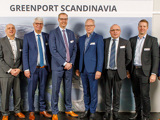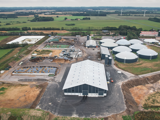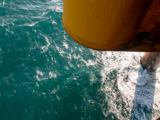New ground-breaking climate cooperation:
Port of Hirtshals will become hub for storing and shipping CO2 from biogas plants in North Jutland
There is enormous climate potential in the agreement, which seven companies have just signed on the transport and storage of biogenic CO2 in North Jutland. The partners will initially transport retained CO2 from local biogas plants to the port of Hirtshals, from where it is shipped out for storage in empty oil fields in the North Sea. The collaboration also involves investigating the possibilities for establishing Europe's largest CO2 hub at the port of Hirtshals.
Storing CO2 is an essential part of the solution to the climate challenges, and now INEOS Energy, Wintershall DEA, Port of Hirtshals, Biocarb Solution, Evida, Blue Water Shipping and Greenport North are taking a big step towards the realization of a visionary project.
Today, the partners have entered into an agreement to investigate the possibility of establishing transport of CO2 from biogas plants in North Jutland, temporary storage facilities at port of Hirtshals and shipping to the North Sea, where the CO2 is pumped underground. The project, known as Greenport Scandinavia, involves the entire value chain for Carbon Capture and Storage (CCS).
- We at INEOS are very far along with our CO2 storage project Greensand, where immediately after the turn of the year we will get the first CO2 into the Danish underground as part of our pilot demonstration project. It is therefore quite natural that we are now looking at how we can create a value chain for the capture, transport and storage of CO2 in Denmark, says Mads Weng Gade and continues:
- Storing biogenic CO2 from biogas plants has a very large climate potential, as negative emissions are thereby achieved. With the entered agreement, we will now, together with the other partners, look at the possibility of establishing the entire value chain and capturing, transporting, and storing the first biogenic CO2 in Denmark.
The partners also state about the project:
CEO Carsten Joest Nielsen, Biocarb Solution:
- The project and the establishment of a CO2 hub will obviously be of great importance of the green transition. The production from biogas is already providing employment and growth to North Jutland - if we reach the goal with the project, we will put the focus on North Jutland as a beacon for green growth.
First Danish storage project with negative emissions
The project is the first of its kind in Denmark, and since it involves biogenic CO2, negative emissions will be achieved, which can make a significant contribution to achieving the Danish climate goals of a 70 percent reduction in greenhouse gas emissions by 2030.
- Biogas has great potential in terms of displacing fossil fuels, and by storing the biogenic CO2 we can even achieve negative emissions. Since it is, among other things, liquid manure from livestock farms that is part of the production, by combining biogas production with CO2 storage, we can at the same time avoid several emissions from agriculture, says CEO Carsten Joest Nielsen from Biocarb Solution.
Initially, the goal is to capture up to 100,000 tonnes of biogenic CO2 annually from North Jutland biogas plants as early as 2024/2025. The CO2 is transported to port of Hirtshals and by ship to the Siri area in the Danish part of the North Sea, where it is stored in empty oil fields through the Greensand project.
In the long term, the ambition is to significantly increase the amount of CO2 that is transported and stored over time and to establish Europe's largest hub for CO2 storage and shipping to fields in the North Sea, starting at the Port of Hirtshals. The port is ideally located in relation to storage fields in the North Sea and receipt of CO2 and will thus become a large, green hub for intermediate storage and shipping of CO2 for both Danish and foreign CO2 emitters. There is thus great potential for growth and utilization of economies of scale.
- We are already working purposefully with plans for the expansion of port of Hirtshals, and in this connection the storage and shipping of CO2 to the North Sea fits perfectly into our strategy. In the long term, the establishment of a CO2 hub in Hirtshals can contribute to solving the climate challenges, and we see great potential in the cooperation we have entered with the other partners, says CEO Per Holm Nørgaard from Port of Hirtshals.
The partners behind the agreement will investigate the possibility of establishing the necessary infrastructure in the form of, for example pipelines for the transport of CO2 from Denmark and other parts of Europe to Hirtshals.
Greenport North, CEO, Steen Hintze:
- There is enormous potential, both climate-wise and business-wise, for the whole of North Jutland in the agreement that has just been signed. Storing CO2 is an essential part of the solution to the climate challenges, and it will be possible to create new companies and jobs, not only in the port of Hirtshals, but in the entire North Jutland.
Peter Kristensen, director of strategy and development at Evida.
- Cost-effective transport of CO2 can support the development of a large-scale CO2 hub in North Jutland, which both contributes to meeting climate targets and supports business development in the area. Evida sees the development and establishment of piped CO2 infrastructure as the knob that can open the doors for just this. We are therefore very much looking forward to the collaboration in this ambitious project, which will create valuable knowledge and experience for all parties, and which will boost the development of a position of strength in North Jutland.
Klaus Langemann, Senior Vice President Carbon Management and Hydrogen in Wintershall Dea.
- Similar to Project Greensand, Greenport Scandinavia fits into our strategy of entering into significant international partnerships around CCS projects. In Greenport Scandinavia, we can contribute with our experience of the entire value chain to create a business model for CCS together with our strong Danish partners and thus support Europe's climate goals.
Jacob Kjærgaard, Regional Director Energy, Ports & Projects Europe, Blue Water Shipping:
- It is a fantastic project that we at Blue Water are delighted to be a part of. We are experts in the execution of transport and logistics, and we think it is very exciting to be able to help develop a new industry. As a global actor with local interest, we want to contribute positively to the green transition, and we therefore participate in various projects with a focus on the green transition and our energy transition.
Facts about CO2 storage
The different steps in CO2 storage are:
- CO2 is captured: CO2 can be captured in many ways. It is most effective to capture it where there is a large and stable supply of CO2. For example, at emitters such as biogas plants, industry, energy production or incineration plants.
- CO2 is liquefied: the captured CO2 is turned into liquid fluid. This can be done by both heating. Compression and cooling.
- CO2 is transported: The liquid CO2 is transported by ships from Hirtshals to the storage areas int he North Sea.
- CO2 is stored underground: Liquid CO2 is sent down into the sandstone reservoir approx. 1800 meters underground via CO2 wells.
- CO2-storage is monitored: The fields for CO2 storage in the underground have been thoroughly screened over several years, and new and ground-breaking technologies are being developed for monitoring the CO2 storage.
Source: Ineos Energy



